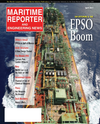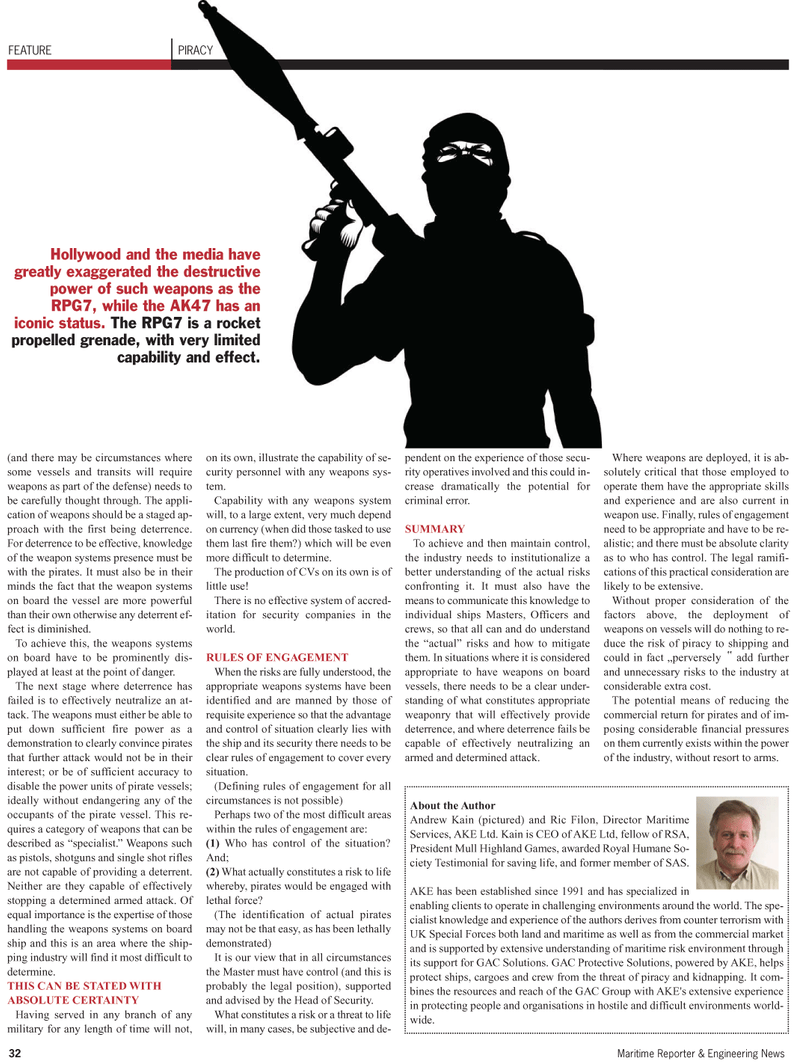
Page 32: of Maritime Reporter Magazine (April 2011)
Offshore Annual
Read this page in Pdf, Flash or Html5 edition of April 2011 Maritime Reporter Magazine
(and there may be circumstances where some vessels and transits will require weapons as part of the defense) needs to be carefully thought through. The appli- cation of weapons should be a staged ap- proach with the first being deterrence.
For deterrence to be effective, knowledge of the weapon systems presence must be with the pirates. It must also be in their minds the fact that the weapon systems on board the vessel are more powerful than their own otherwise any deterrent ef- fect is diminished.
To achieve this, the weapons systems on board have to be prominently dis- played at least at the point of danger.
The next stage where deterrence has failed is to effectively neutralize an at- tack. The weapons must either be able to put down sufficient fire power as a demonstration to clearly convince pirates that further attack would not be in their interest; or be of sufficient accuracy to disable the power units of pirate vessels; ideally without endangering any of the occupants of the pirate vessel. This re- quires a category of weapons that can be described as “specialist.” Weapons such as pistols, shotguns and single shot rifles are not capable of providing a deterrent.
Neither are they capable of effectively stopping a determined armed attack. Of equal importance is the expertise of those handling the weapons systems on board ship and this is an area where the ship- ping industry will find it most difficult to determine.
THIS CAN BE STATED WITH
ABSOLUTE CERTAINTY
Having served in any branch of any military for any length of time will not, on its own, illustrate the capability of se- curity personnel with any weapons sys- tem.
Capability with any weapons system will, to a large extent, very much depend on currency (when did those tasked to use them last fire them?) which will be even more difficult to determine.
The production of CVs on its own is of little use!
There is no effective system of accred- itation for security companies in the world.
RULES OF ENGAGEMENT
When the risks are fully understood, the appropriate weapons systems have been identified and are manned by those of requisite experience so that the advantage and control of situation clearly lies with the ship and its security there needs to be clear rules of engagement to cover every situation. (Defining rules of engagement for all circumstances is not possible)
Perhaps two of the most difficult areas within the rules of engagement are: (1) Who has control of the situation?
And; (2) What actually constitutes a risk to life whereby, pirates would be engaged with lethal force? (The identification of actual pirates may not be that easy, as has been lethally demonstrated)
It is our view that in all circumstances the Master must have control (and this is probably the legal position), supported and advised by the Head of Security.
What constitutes a risk or a threat to life will, in many cases, be subjective and de- pendent on the experience of those secu- rity operatives involved and this could in- crease dramatically the potential for criminal error.
SUMMARY
To achieve and then maintain control, the industry needs to institutionalize a better understanding of the actual risks confronting it. It must also have the means to communicate this knowledge to individual ships Masters, Officers and crews, so that all can and do understand the “actual” risks and how to mitigate them. In situations where it is considered appropriate to have weapons on board vessels, there needs to be a clear under- standing of what constitutes appropriate weaponry that will effectively provide deterrence, and where deterrence fails be capable of effectively neutralizing an armed and determined attack.
Where weapons are deployed, it is ab- solutely critical that those employed to operate them have the appropriate skills and experience and are also current in weapon use. Finally, rules of engagement need to be appropriate and have to be re- alistic; and there must be absolute clarity as to who has control. The legal ramifi- cations of this practical consideration are likely to be extensive.
Without proper consideration of the factors above, the deployment of weapons on vessels will do nothing to re- duce the risk of piracy to shipping and could in fact „perversely -add further and unnecessary risks to the industry at considerable extra cost.
The potential means of reducing the commercial return for pirates and of im- posing considerable financial pressures on them currently exists within the power of the industry, without resort to arms. 32 Maritime Reporter & Engineering News
FEATURE PIRACY
About the Author
Andrew Kain (pictured) and Ric Filon, Director Maritime
Services, AKE Ltd. Kain is CEO of AKE Ltd, fellow of RSA,
President Mull Highland Games, awarded Royal Humane So- ciety Testimonial for saving life, and former member of SAS.
AKE has been established since 1991 and has specialized in enabling clients to operate in challenging environments around the world. The spe- cialist knowledge and experience of the authors derives from counter terrorism with
UK Special Forces both land and maritime as well as from the commercial market and is supported by extensive understanding of maritime risk environment through its support for GAC Solutions. GAC Protective Solutions, powered by AKE, helps protect ships, cargoes and crew from the threat of piracy and kidnapping. It com- bines the resources and reach of the GAC Group with AKE's extensive experience in protecting people and organisations in hostile and difficult environments world- wide.
Hollywood and the media have greatly exaggerated the destructive power of such weapons as the
RPG7, while the AK47 has an iconic status. The RPG7 is a rocket propelled grenade, with very limited capability and effect.

 31
31

 33
33
